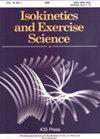柔道运动员的上肢在肩部内外旋肌的同心力量方面是否存在差异?
IF 0.7
4区 医学
Q4 ENGINEERING, BIOMEDICAL
引用次数: 0
摘要
背景:长期的柔道训练会导致运动员在发力时出现上肢不对称和肩部不对称,主要表现在拉、推和投掷动作中;这对肩部内外旋肌的力量和速度要求较高,也可能导致肩部损伤或柔道成绩下降。目的:研究高水平柔道运动员在角速度为 60、180 和 300∘/秒时,优势上肢和非优势上肢肩部内外旋肌同心力量的不对称性。方法:14 名训练有素的男性柔道运动员(年龄 24.4 ± 4.8 岁;体重 87.9 ± 18.7 千克;身高 1.8 ± 0.1 米)。所有参与者均在等速测力计(Cybex® Humac Norm 测力计 CSMI,型号 502140)上以 3 种角速度(60∘/s、180∘/s 和 300∘/s)进行了 5 次肩部同心内旋和外旋运动。数据采用独立 t-学生(离散分析)和统计参数映射(SPM)曲线(一维分析)进行分析。在离散分析中,优势与非优势没有差异(P> 0.05)。在 SPM 分析中,优势与非优势没有差异。所有比较均未超过 t 检验的比较临界值(tcrit)(p> 0.05)。结论:根据离散和一维(SPM)分析结果,柔道运动员与优势上肢和非优势上肢相比,肩关节外旋肌或内旋肌的同心力没有明显的不对称性。本文章由计算机程序翻译,如有差异,请以英文原文为准。
Do judokas present differences between upper limbs for the concentric strength of the internal and external rotators of the shoulder?
BACKGROUND: Long-time judo training can lead athletes to develop upper limb asymmetry and shoulder asymmetry during force production, mainly in the action of pulling, pushing, and throwing; that requires higher strength and velocity of the internal and external rotators of the shoulders, which may also result in shoulder injury, or a decrease in judo performance. OBJECTIVE: To investigate asymmetries in concentric force of the internal and external shoulder rotators of the dominant and non-dominant upper limbs in high-level judokas at angular velocities of 60, 180, and 300∘/s. METHODS: 14 highly trained male judokas (age 24.4 ± 4.8 yrs.; body mass 87.9 ± 18.7 kg; height 1.8 ± 0.1 m). All participants performed 5 attempts of movement concentric internal and external rotation of the shoulder with 3 angular velocities (60∘/s, 180∘/s, and 300∘/s) in an isokinetic dynamometer (Cybex® Humac Norm Dynamometer CSMI, model 502140). The data were analyzed by independent t-student (discrete analysis) a statistical parametric mapping (SPM) curve (one-dimensional analysis). There was no difference in dominant vs. non-dominant for discrete analysis (p> 0.05). There was no difference in dominant vs. non-dominant for SPM analysis. None of the comparisons surpassed the comparison cut-off (tcrit) for the t-test (p> 0.05). CONCLUSIONS: Based on results, judokas do not present significant asymmetries in concentric force of external or internal shoulder rotators when compared to the dominant vs. the non-dominant upper limb according to discrete and one-dimensional (SPM) analysis.
求助全文
通过发布文献求助,成功后即可免费获取论文全文。
去求助
来源期刊

Isokinetics and Exercise Science
医学-工程:生物医学
CiteScore
1.20
自引率
14.30%
发文量
37
审稿时长
>12 weeks
期刊介绍:
Isokinetics and Exercise Science (IES) is an international journal devoted to the study of theoretical and applied aspects of human muscle performance. Since isokinetic dynamometry constitutes the major tool in this area, the journal takes a particular interest in exploring the considerable potential of this technology.
IES publishes studies associated with the methodology of muscle performance especially with respect to the issues of reproducibility and validity of testing, description of normal and pathological mechanical parameters which are derivable from muscle testing, applications in basic research topics such as motor learning paradigms and electromyography. The journal also publishes studies on applications in clinical settings and technical aspects of the various measurement systems employed in human muscle performance research.
The journal welcomes submissions in the form of research papers, reviews, case studies and technical reports from professionals in the fields of sports medicine, orthopaedic and neurological rehabilitation and exercise physiology.
 求助内容:
求助内容: 应助结果提醒方式:
应助结果提醒方式:


